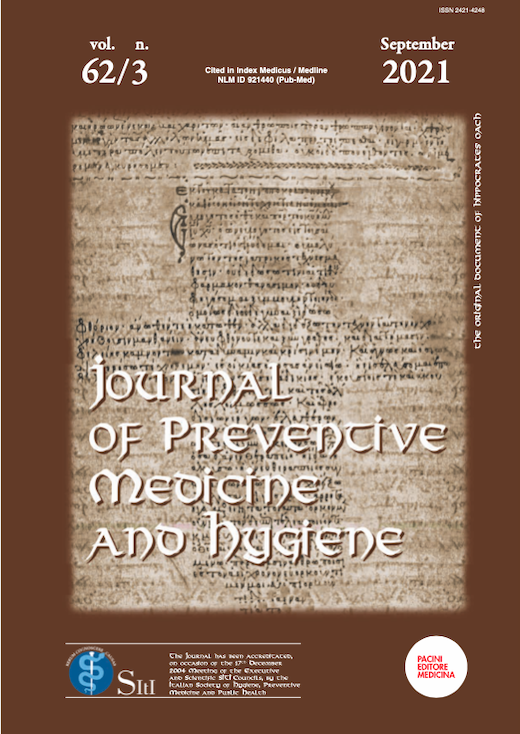Abstract
Aims - Genoa is a city hit by a strong economic, demographic and social involution. The changes in the demographic and socio-economic (SE) situation were analysed and the capacity of two Socio-Economic and Health Deprivation Indices (SEHDI) in describing the evolutions of the recent period were verified.
Material and Methods – The data about the evolution of demographic and SE situation in Genoa came from publications of Statistics Offices of Genoa Municipality and Liguria Region and from published analyses of Bank of Italy. The two SEHDIs, referring to 2001 and 2011 population, were computed at census tract level by linear regression, factor and clusters analyses and had been already validated and published.
Results – Wide transformations in aging and population composition by age groups and gender occurred in Genoa between 1951 and 2016. Internal (from other Italian regions) and external (from other countries) migrations concurred to change the profile of Genoese population. These changes followed the industrial history of city and its deindustrialization occurred since 2001. A progressive SE involution, worsened by the Italian and international crises, carried out the recent impoverishment of the city. Between 2001 and 2011 the population at medium-high deprivation increased and the SEHDIs 2001 and 2011 contributed to describe the population distribution by deprivation groups, either geographically, and by groups of citizenships (Italians and Foreigners). The first identified in 2001 some aspects of a well-off society regarding education, labour market and characteristics of the family and housing structure. The second depicted in 2011 an impoverished society in aging, lack of family support and of property of the main house, diminishing of educational level.
Discussion - Genoa city demonstrated an its own specific decline. Starting from the deindustrialization, a worsening of welfare, independently from the national and international economic troubles, was evident. The aging and the changed equilibria among age groups testified the growing difficulties of society in keeping up with the deep social and economic changes. The results demonstrated that specific deprivation indices aid to better define the populations under analysis, because they identify the subpopulations that could have the maximum benefit from investments of resources targeted to the correction of inequalities.
References
2. Arvati P. (ed.) Rapporto Statistico Liguria. Analisi storica 1861-2011. Genoa, Italy: Sistema Statistico Nazionale. 2007.
3. Banca d’Italia - Eurosistema. Economie regionali. L’economia della Liguria. No. 7 – June 2018. Rome, Italy: Banca d’Italia, 2018.
4. ISTAT. Population and households: XIV Italian National Census. Rome, Italy: ISTAT, 2001. https://www.istat.it/it/censimenti-permanenti/censimenti-precedenti/popolazione-e-abitazioni/popolazione-2001.
5. ISTAT. Population and households: XV Italian National Census. Rome, Italy: ISTAT, 2011. https://www.istat.it/it/censimenti-permanenti/censimenti-precedenti/popolazione-e-abitazioni/popolazione-2011.
6. Lillini R, Quaglia A, Vercelli M; Registro mortalità Regione Liguria. [Building of a local deprivation index to measure the health status in the Liguria Region]. [Article in Italian] Epidemiol Prev. 2012;36(3-4):180-187.
7. Lillini R, Vercelli M. The local Socio-Economic Health Deprivation Index: methods and results. J Prev Med Hyg. 2018;59(4S2):E3-E10.
8. Tabachnick BG., Fidell LS. Using Multivariate Statistics (4th ed.). Boston, MA: Allyn and Bacon, 2001.
9. Agnelli JP, Cadeiras M, Tabak EG, Turner CV, Vanden-Eijnden E. Clustering and classification through normalizing flows in feature space. Multiscale Model. Simul. 2010;8(5):1784-1802.
10. Neckerman K. (ed.) Social Inequality. New York, NY: Russell Sage Foundation, 2004.
11. Marmot MG, Smith GD. Socio-economic Differentials in Health. J Health Psychol. 1997;2(3):283-296.
12. Carstairs V. Deprivation indices: their interpretation and use in relation to health. J Epidemiol Community Health. 1995;49 Suppl 2:S3-S8.
13. Scarpa S. Immigration policy regimes, welfare states and urban inequality patterns: A comparison between Malmö and Genoa. European Urban and Regional Studies. 2015;23(4):862-877
14. Palumbo M, Poli S. Aging in the Contemporary Urban Context: The Mortality Rates of Older Residents in Genoa, Italy. City Networks. 2017:157-175.
15. Casanova G, Lamura G, Principi A. Valuing and Integrating Informal Care as a Core Component of Long-Term Care for Older People: A Comparison of Recent Developments in Italy and Spain. J Aging Soc Policy. 2017;29(3):201-217.
16. Conti S, Farchi G, Masocco M, Minelli G, Toccaceli V, Vichi M. Gender differentials in life expectancy in Italy. Eur J Epidemiol. 2003;18(2):107-112.
17. von Strauss E, Agüero-Torres H, Kåreholt I, Winblad B, Fratiglioni L. Women are more disabled in basic activities of daily living than men only in very advanced ages: a study on disability, morbidity, and mortality from the Kungsholmen Project. J Clin Epidemiol. 2003;56(7):669-677.
18. Betti E. Gender and Precarious Labor in a Historical Perspective: Italian Women and Precarious Work between Fordism and Post-Fordism. International Labor and Working Class History. 2016;89:64-83.
19. Busetta G, Fiorillo F, Palomba G. The impact of attractiveness on job opportunities in Italy: a gender field experiment. Economia Politica. 2020. https://doi.org/10.1007/s40888-020-00194-5
20. McKinsey Global Institute. Urban world: Meeting the demographic challenge. McKinsey & Company, 2016:1-48. https://www.mckinsey.com/featured-insights/urbanization/urban-world-meeting-the-demographic-challenge-in-cities# (last access: 27th August 2020).
21. Mattei G, De Vogli R, Ferrari S, Pingani L, Rigatelli M, Galeazzi GM. Impact of the economic crisis on health-related behaviors in Italy. Int J Soc Psychiatry. 2017;63(7):649-656.
22. Masters RK, Link BG, Phelan JC. Trends in education gradients of 'preventable' mortality: a test of fundamental cause theory. Soc Sci Med. 2015;127:19-28.
23. Scafato E, Gandin C, Galluzzo L, Scipione R, Vichi M, Ghirini S, CSDA Working Group. Epidemiology and alcohol-related monitoring in Italy and in the Regions. Evaluation of the National Observatory on Alcohol on the impact of the alcohol consumption in support for the implementation of the activities of the National Alcohol and Health Plan. Report 2017. Rome, Italy: ISS, 2017. http://old.iss.it/publ/?lang=1&id=3037&tipo=5 (last access: 27th August 2020).
24. Lantz PM, Golberstein E, House JS, Morenoff J. Socioeconomic and behavioral risk factors for mortality in a national 19-year prospective study of U.S. adults. Soc Sci Med, 2010;70(10):1558-1566.
25. Rondon Garcia LM, Aguirre Arizala BA, Garcia Garcia FJ, Gallego CC. Support and Social Contact as a Decisive Meta-Variable in Morbidity and Social Welfare of the Older Person. Curr Aging Sci. 2017;10(4):282-290.
26. Olaya B, Domènech-Abella J, Moneta MV, Lara E4, Caballero FF, Rico-Uribe LA, Haro JM. All-cause mortality and multimorbidity in older adults: The role of social support and loneliness. Exp Gerontol. 2017;99:120-126.


